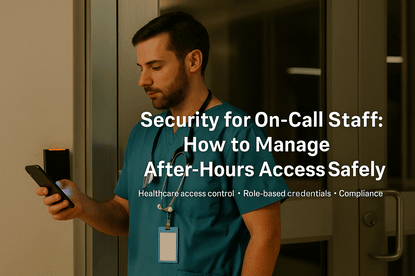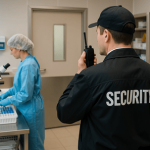
In healthcare, emergencies don’t respect business hours. When patients need care, staff must come and go—sometimes at 2 a.m., on weekends, or during holidays. That’s why after-hours access control is one of the most important—and most overlooked—parts of a facility’s security strategy.
At SSP, we help hospitals, urgent care centers, clinics, and senior living communities manage the fine balance between secure buildings and responsive staffing.
If your doors are locked but your mission never sleeps, this blog is for you.
k
k
🚨 Why After-Hours Access Is a Unique Security Challenge
Unlike schools or offices, healthcare facilities can’t shut down at night. But after-hours movement still comes with added risks:
-
Fewer staff are on-site to monitor access
-
Higher risk of tailgating or unauthorized entry
-
Patient privacy and safety remain critical
-
On-call staff may not have full-time credentials
If your access control doesn’t account for these edge cases, you’re relying on luck and good intentions instead of a secure, reliable system.
k
k
🔑 What Makes After-Hours Access Different?
1. Unpredictable Schedules
On-call surgeons, respiratory therapists, behavioral health professionals—they may arrive at any hour, on short notice.
2. Multiple Entry Points
A staffer might need to enter through an emergency bay, a back entrance, or a stairwell instead of the front lobby.
3. Fewer Front Desk Personnel
Without reception or security at the door, your access control must do more of the work to verify identity.
k
k
🛡️ How to Secure After-Hours Healthcare Access the Right Way
🔐 1. Use Role-Based Access Credentials
Assign digital credentials that only work:
-
During approved hours
-
For approved doors
-
For approved individuals
If an on-call pediatrician doesn’t need access to the pharmacy wing, they shouldn’t have it—especially after-hours.
Tip: Cloud-based platforms allow you to update or revoke access instantly, without a badge printer or in-person handoff.
k
k
📱 2. Consider Mobile Credentials for On-Call Staff
Staff can use secure smartphone credentials (with Face ID or PIN) to:
-
Enter buildings from designated entrances
-
Bypass front desk check-in without losing traceability
-
Authenticate with time-stamped logs
This improves convenience and compliance—especially in environments where temporary or rotating staff are common.
k
k
🎥 3. Pair Access Control with Smart Video Verification
Use IP-based surveillance to log and review after-hours entries in real time or after the fact. For example:
-
Confirm who used which badge
-
Review motion-triggered clips
-
Ensure no one tailgated or forced entry
Video gives you eyes on the ground—even when security isn’t physically there.
k
k
🧾 4. Keep an Audit Trail for Compliance
HIPAA doesn’t sleep, and neither should your documentation.
Access logs can help prove:
-
Who entered sensitive areas (like medical records or medication storage)
-
When they were on-site
-
Whether access was properly restricted
This is vital for incident investigation, accountability, and regulatory audits.
k
k
🤝 5. Communicate Access Expectations with On-Call Teams
Even the best technology can fail if people aren’t trained. Be sure on-call and rotating staff understand:
-
Which entrances they should use
-
Which areas they’re authorized to access
-
Who to contact if their credential doesn’t work
-
What to do if they observe a breach or issue
A quick orientation—or even a short video—can prevent confusion and security gaps.
k
k
Final Thoughts: Secure Doesn’t Have to Mean Inconvenient
The best after-hours access strategies blend safety with flexibility. Your team deserves to move efficiently without jumping through hoops—and your patients deserve to be protected at all hours.
At SSP, we design smart, role-based, and mobile-ready access control systems that work for hospitals, clinics, and senior care facilities—around the clock.


